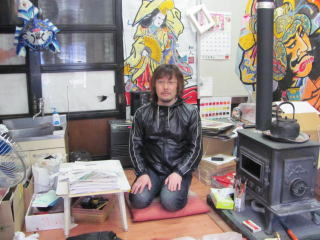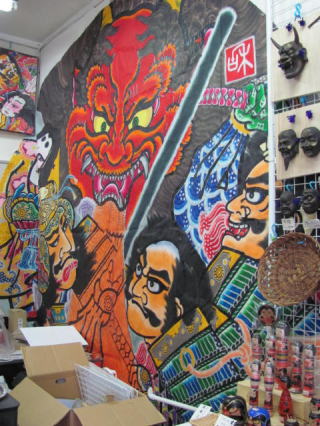|
We introduce Handwork, traditional crafts, folk art and traditional foods
made by craftsmen in the Tohoku region of Japan ,
that have been handed down from generation to generation,
and sell them by mail order .
・・・We advocate Life with Japanese beauty.・・・ |
Tsugaru kite painting
Shukou Yamauchi
|
It is said that the first record of kite flying in Hirosaki is from the late Edo period, but it became popular from the mid Meiji period, and around this time, Tsugaru kite painting was established, which is mainly a large neck painting of a samurai (warrior). |



 |
- Today, I visited Mr. Shukou Yamauchi (Kazuto) in Matsumori-cho, Hirosaki City. During my seven years of living in Hirosaki, I had participated in the "Neputa" festival, and the floats were magenta. Mr. Yamauchi is one of them. There are two types of Neputa picture and the sending picture of the return beauty.
(2011.03.07, a few days before the Great East Japan Earthquake)
- I arrived in Hirosaki early in the morning and called him before I went there.
He was very passionate about the community. There was a shop with a sign
that said "Neputa-ya", and it displayed and sold the products
of young artists who are friends and acquaintances. He said that he was
keeping the products because he wanted to give them a chance to sell even
a little bit. One of the dolls was a Shitakawara Yaki humanoid, and the
artist, Mr. Masashi Abo, was there, and I was able to meet him with his
introduction.
- One of Mr. Yamauchi's works was "Tsugaru Kite painting".
The Tsugaru kite painting is said to have inherited the traditional Edo kite painting and was not unique to Tsugaru.
As his creation, he drew Tsugaru warlords as subjects and depicted the four gods as "Blue Dragon, White Tiger, Suzaku and Genbu".
In addition, although it was traditionally a red fish puppet, a blue fish puppet was created.
It's very nice, it's on display in the store, and it's appropriate in shape and size.
- Shimotsuke, Aizu, Tsugaru The specialized in Handicrafts will be selling Tsugaru kite paintings and Kingyoneputa, both traditional Tsugaru folk crafts made by Mr. Yamauchi.
From the photo, I would like to introduce Mr. Yamauchi's "Neputaya".
|
[Tsugaru kite painting]
- It is said that the first record of kite flying in Hirosaki is from the late Edo period, but it became popular from the mid Meiji period, and around this time, Tsugaru kite painting was established, which is mainly a large neck painting of a samurai (warrior).
- Influenced by the ukiyo-e artists of Edo, Tsugaru kite paintings are warrior paintings based on heroes and great men and women who appeared in the Three Kingdoms and Suikoden, as well as warlords from Japanese history.
It is painted with thick, powerful ink lines and vivid primary colors such as red, black and green. In the Edo period (1603-1868), "Tsugaru kites" were made as a side job for the impoverished samurai of the Hirosaki domain.
It is recorded that a number of kites were flown in Hirosaki, the castle town of the Tsugaru clan, during the Tenpo period.
- It is said that the style of kites is strongly influenced by Hokusai Katsushika.
It is said to have been completed by Iwanzo Odagiri, who established this design by a certain Shibata.
- The warlord on the Tsugaru kite also represents the parents' wish that he or she will grow up to be a strong and strong person.
This is a historic local toy that has been loved by many people since ancient times.
The Tsugaru kite paintings in the collection of Hirosaki City Museum are from the Meiji era to the Showa era.
- Tsugaru kites are known for their brave warrior pictures (a traditional Tsugaru design), and the bones are made of hiba wood instead of bamboo. The kite is made from thinly split hibachi wood and is about two tatami mat lengths long.
On the back of the kite is a thick paper called "Bunbu", which vibrates when you fly the kite and makes a buzzing sound as it flies through the sky.
It's also sold as a kite painting.
- Normally, it takes five years for a Tsugaru kite painter to become an apprentice and then to be able to help.
With paper and wood, you don't know until you try it.
- Types of techniques and processes
Kite Painting ⇒ Color Painting ⇒ Gluing ⇒ Finishing ⇒ Finishing Color ⇒ Kite Bone Processing ⇒ Finishing ⇒ Assembling
Paper, wood (birch wood)
【1】 Drawing a kite picture
Draw a kite pattern.
【2】 Coloring.
Color the finished picture.
【3】 Adding an ulterior motive
Stick a thick piece of paper called "Bunbu" on the back of the kite.
【4】 Finishing color
Coloring of the finish is done.
【5】 Kite bone processing
Process the frame of the kite.
【6】 Finishing and assembling
The final touches are then combined to complete the kite.
|
[Origin of Neputa]
- Hirosaki Neputa Festival is a summer festival held in Hirosaki City, Aomori Prefecture, one of the four major festivals in Hirosaki (Hirosaki Sakura Festival, Neputa, Hirosaki Castle Chrysanthemum and Autumn Foliage Festival, and Hirosaki Castle Snow Lantern Festival).
- Many citizens parade around the city, pulling floats with warrior pictures on them, while shouting "Yaya Do". Hirosaki Neputa has two types of Neputa (fan type) and kumi-neputa (puppet type), with a total of 80 Neputa, the largest number in the prefecture.
- The etymology of the word is "Nemuta-nagashi" → "Nemuta-nagashi" → "Nemuta" → "Neputa" (there are various notations such as Nekibuta and Nekuta). Nurenagashi is practiced in many parts of Japan. This is one of the rituals to chase away the drowsiness that comes with the heavy farming season in the summer, and to pour out the evil and evil in the water and send them out of the village.
- From the Meiji period (1868-1912) to the early Showa period (1926-1989), there were several town dojos in Hirosaki City at that time where young people, mainly warriors and commoner children, made and practiced Neputa. When they encountered other Neputa from other dojos or town associations, they threw stones at the other Neputa or fought with bamboo spears or wooden swords (sometimes with Japanese swords), often resulting in deaths and injuries. This is called "Kankaneputa". (Some of the vestiges are written on the shoulders of the neputa.
- The order of each group is as follows: Mae-no-go (lanterns) and Machi-mirushi (town seal) with the name of the town association or group at the beginning, then Mae-no-neta (square lanterns or small neta), the front performers who pull the rope connected to the neta, then the large neta (fans or troupes) and the musicians who play drums and flutes. There are three types of Neputahayashi: progression, pause, and return. The shouting is "yayadoh" for progress, "neputah" for return, and "yare yare yare yare".
|
【Syukou Yamauchi, painter Biography】
- Born in Hirosaki City, Aomori Prefecture
Born October 6, 1963.
- On his 50th birthday in 2013, he changed his name from Kazuto Yamauchi to Takashi Yamauchi.
- Currently, while working as a painter, designer and nepeta-eater, she teaches
Tsugaru ékko and Tsugaru nishiki-e (nepta Tsugaru kite painting) at York
Culture Hirosaki.
- Read more
|
|
【Kind】
- All prices are listed in the table below. A separate consumption tax will be added.
- These Tsugaru kite paintings are paintings only.
(It's not a kite with a frame.)
- It may take several months depending on the busy season, so please contact
us.
- The price of a framed picture differs depending on the type of the frame,
so please consult with us.
- The size will be on a scale of Nishinouti (west inside).
One sheet (333mm x 485mm) of Nishinouti (west inside) is two sheets of
half-paper (243mm x 333mm).
▶Toppage □up |
|
2010/04/20 The homepage is now open.
Topy Planning ltd.
100-467, Toyoura-nakamachi, Nasushiobara-City, Tochigi-ken
325-0063, Japan
tel/fax +81287-62-7673 Cell phone number: +8180-5089-9227 |

